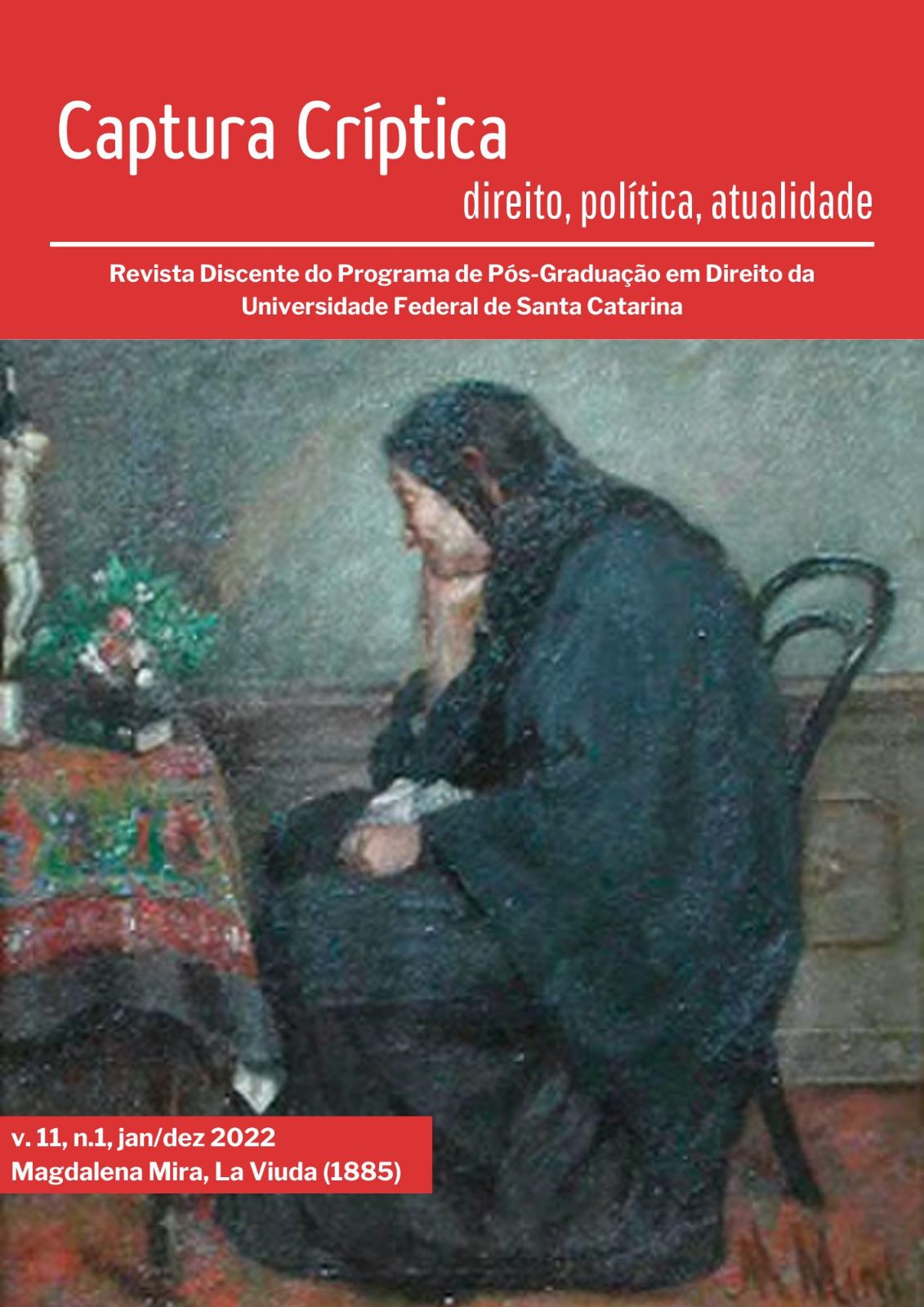Mulheres ou bruxas? A invenção da mulher menos humana
Palavras-chave:
Direitos Humanos, Caça à Bruxas, Feminismo marxistaResumo
O presente artigo pretende entender as diferenças do reconhecimento de direitos humanos atribuíveis a homens e mulheres. Investigando historicamente a invenção desses direitos no bojo das revoluções liberais, tem-se que a categoria de “não-humanos” foi o outro lado da moeda desse momento tão entoado: igualdade, liberdade e fraternidade sim - mas apenas para um padrão específico. Um padrão que é masculino e foi sendo marcado em superioridade ao longo dos mais de dois séculos da perseguição das mulheres como bruxas. Para entender a invenção da “mulher não-humana” é, portanto, fundamental revisitar criticamente a prolongada caça às bruxas na Europa, responsável pelo assentamento das diferenciações de gênero e pela estruturação de um sistema de exploração das mulheres que possibilitasse a sobrevivência do capitalismo. A mulher não-humana foi, pois, estrategicamente construída como um pilar da sociedade capitalista.
Referências
BARSTOW, Anne Llewellyn. Witchcraze: a new history of the european witch hunts, our legacy of violence against women. Nova York: Pandora Harper Collins, 1994.
BUENO, Samira et al. A violência contra meninas e mulheres no ano pandêmico. Fórum Brasileiro de Segurança Pública, 15 jul. 2021. Disponível em: <https://forumseguranca.org.br/wp-content/uploads/2021/07/6-a-violencia-contra-meninas-e-mulheres-no-ano-pandemico.pdf>. Acesso em: 06 set. 2021.
BRASIL. Decreto nº 4.377, de 13 de setembro de 2002. Promulga a Convenção sobre a Eliminação de Todas as Formas de Discriminação contra a Mulher, de 1979, e revoga o Decreto no 89.460, de 20 de março de 1984. Diário Oficial da União. Brasília, 13 de setembro de 2002; 181o da Independência e 114o da República.
BRASIL. Lei nº 13.104, de 9 de março de 2015. Altera o art. 121 do Decreto-Lei nº 2.848, de 7 de dezembro de 1940 - Código Penal, para prever o feminicídio como circunstância qualificadora do crime de homicídio, e o art. 1º da Lei nº 8.072, de 25 de julho de 1990, para incluir o feminicídio no rol dos crimes hediondos. Brasília, 9 de março de 2015; 194º da Independência e 127º da República.
EPISÓDIO 1: O Crime da Praia dos Ossos. [Locação de]: Branca Vianna. Entrevistados: Jacqueline Pitanguy; Hildete Pereira de Melo; Artur Xexéo et al. Rio de Janeiro, 11 set 2020. Podcast. (Série Praia dos Ossos). Disponível em: <https://www.radionovelo.com.br/praiadosossos/o-crime-da-praia-dos-ossos>. Acesso em: 06 set 2021.
EPISÓDIO 2: O Julgamento. [Locação de]: Branca Vianna. Entrevistados: Jacqueline Pitanguy; Hildete Pereira de Melo; Artur Xexéo et al. Rio de Janeiro, 19 set 2020. Podcast. (Série Praia dos Ossos). Disponível em: <https://www.radionovelo.com.br/praiadosossos/o-julgamento>. Acesso em: 06 set 2021.
EPISÓDIO 7: Quem ama não mata. [Locação de]: Branca Vianna. Entrevistados: Jacqueline Pitanguy; Hildete Pereira de Melo; Artur Xexéo et al. Rio de Janeiro, 24 out 2020. Podcast. (Série Praia dos Ossos). Disponível em: <https://www.radionovelo.com.br/praiadosossos/quem-ama-nao-mata>. Acesso em: 06 set 2021.
FEDERICI, Silvia. Calibã e a Bruxa. São Paulo: Editora Elefante, 2019.
FONSECA, Cláudia; CARDARELLO, Andrea. Direitos dos mais e menos humanos. Horizontes antropológicos, Porto Alegre, ano 5, n. 10, p. 83-121, maio 1999.
GOUGES, Olympe de. Declaração dos direitos da mulher e da cidadã. França, 1791. Disponível em: <http://www.direitoshumanos.usp.br/index.php/Documentos-anteriores-%C3%A0-cria%C3%A7%C3%A3o-da-Sociedade-das-Na%C3%A7%C3%B5es-at%C3%A9-1919/declaracao-dos-direitos-da-mulher-e-da-cidada-1791.html>. Acesso em 06 set 2021.
HANCOCK et al. A Declaração de Independência dos Estados Unidos da América. Tradução disponível em: <http://www.uel.br/pessoal/jneto/gradua/historia/recdida/declaraindepeEUAHISJNeto.pdf>. Acesso em 06 set. 2021.
HELENE, Diana. A mordaça “anti-bruxa”: design para exclusão de mulheres do espaço público. FeminismUrbana, 16 nov. 2017. Disponível em: <https://feminismurbana.wordpress.com/2017/11/16/a-mordaca-anti-bruxa-design-para-exclusao-de-mulheres-do-espaco-publico-e-politico/>. Acesso em 06 set 2021.
HUNT, Lynn. A invenção dos direitos humanos - uma história. São Paulo: Companhia das Letras, 2007.
IBGE. Estatísticas de gênero - Indicadores sociais das mulheres no Brasil. Disponível em: <https://www.ibge.gov.br/estatisticas/multidominio/genero/20163-estatisticas-de-genero-indicadores-sociais-das-mulheres-no-brasil.html>. Acesso em: 06 set. 2021.
KORS, Alan C.; PETERS, Edward. Witchcraft in Europe 1100-1700: a documentary history. Filadélfia, University of Pennsylvania Press, 1972.
MARX, Karl. O Capital: crítica da economia política. O processo de produção do capital Livro I. São Paulo: Boitempo, 2011.
ROSEN, Barbara. A bruxaria na Inglaterra 1558-1618. Amherst: University of Massachusetts Press, 1969.
SLIWINSKI, Sharon. The Childhood of Human Rights: The Kodak on the Congo. Journal of Visual Culture, v. 5, n, 3, p. 333-363, 2006.
TAVASSI et al. A história dos direitos das mulheres. Poltize, 30 mar. 2021. Disponível em: <https://www.politize.com.br/equidade/blogpost/historia-dos-direitos-das-mulheres/>. Acesso em: 06 set. 2021.
THOMAS, Keith. Religion and the Decline of Magic. Nova York: Charles Scribner's Sons, 1971.
WOLLSTONECRAFT, Mary. Reivindicação dos Direitos da Mulher. São Paulo: Boitempo, 2016 [1792].
Downloads
Publicado
Edição
Seção
Licença
Copyright (c) 2022 Captura Críptica: direito, política, atualidade

Este trabalho está licenciado sob uma licença Creative Commons Attribution-NonCommercial-NoDerivatives 4.0 International License.
Os trabalhos publicados na Revista Captura Críptica estão sob a Licença Creative Commons Attribution-NonCommercial-NoDerivatives 4.0 International.










